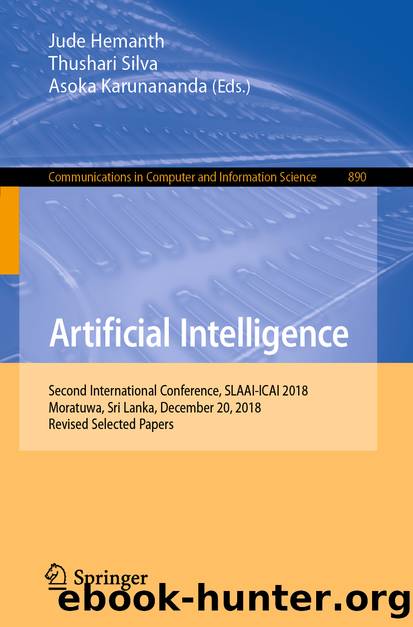Artificial Intelligence by Unknown

Author:Unknown
Language: eng
Format: epub
ISBN: 9789811391293
Publisher: Springer Singapore
2.Opening hours of the attraction
3.Busy Hours
4.Suitable Audience
5.Constraints – food/drinks allowed/not allowed, dress code, photography allowed/not allowed
6.Whether necessary equipment will be provided or not – safety gear, maps etc.
7.The best season to visit the attraction
8.Reservations
9.The importance of the attraction
10.Suggestions for places that can be visited
11.Tickets
The classification stage uses 3 classifiers to classify the question. The correct category is identified as the category classified by the majority or the category given by the classifier with the maximum accuracy.
When a question is submitted by the user to the system, it is preprocessed before the classification stage. The question submitted is checked to see whether it is a general sentence such as a greeting or whether a user is asking for an image. These kind of questions are not sent for classification. If it is a general sentence, a matching response is submitted based on a list of general sentences and matching responses maintained. If the user is requesting for images, the relevant attraction is retrieved and sent to display images to the user.
After filtering out the above scenarios, the input given to the system is separated as general information sentences and questions. This is done to avoid classifying the general statements as well since the classifiers are trained only on questions and will not give an accurate classification for the general informative sentences given by the user. The questions are identified using a set of question words and general key words that can appear on a question.
Then the attraction name the user is referring to is identified by matching against a list of locations available in the knowledge base. If the user given attraction name is not available in the list of attraction names in the knowledge base, a part of speech pattern matching is used to identify the attraction name using proper noun tags. The attraction names identified are replaced by a general reference, “it”, in order to avoid the misclassification that might occur since the specific name of the attraction should not be important in classifying the question. The classification approaches used are explained below.
Download
This site does not store any files on its server. We only index and link to content provided by other sites. Please contact the content providers to delete copyright contents if any and email us, we'll remove relevant links or contents immediately.
Algorithms of the Intelligent Web by Haralambos Marmanis;Dmitry Babenko(16280)
Jquery UI in Action : Master the concepts Of Jquery UI: A Step By Step Approach by ANMOL GOYAL(9408)
Test-Driven Development with Java by Alan Mellor(7738)
Data Augmentation with Python by Duc Haba(7614)
Principles of Data Fabric by Sonia Mezzetta(7383)
Learn Blender Simulations the Right Way by Stephen Pearson(7296)
Microservices with Spring Boot 3 and Spring Cloud by Magnus Larsson(7142)
Hadoop in Practice by Alex Holmes(6589)
RPA Solution Architect's Handbook by Sachin Sahgal(6519)
The Infinite Retina by Robert Scoble Irena Cronin(6220)
Big Data Analysis with Python by Ivan Marin(5938)
Life 3.0: Being Human in the Age of Artificial Intelligence by Tegmark Max(5520)
Pretrain Vision and Large Language Models in Python by Emily Webber(4897)
Infrastructure as Code for Beginners by Russ McKendrick(4658)
Functional Programming in JavaScript by Mantyla Dan(4441)
WordPress Plugin Development Cookbook by Yannick Lefebvre(4388)
The Age of Surveillance Capitalism by Shoshana Zuboff(4253)
Embracing Microservices Design by Ovais Mehboob Ahmed Khan Nabil Siddiqui and Timothy Oleson(4149)
Applied Machine Learning for Healthcare and Life Sciences Using AWS by Ujjwal Ratan(4137)
